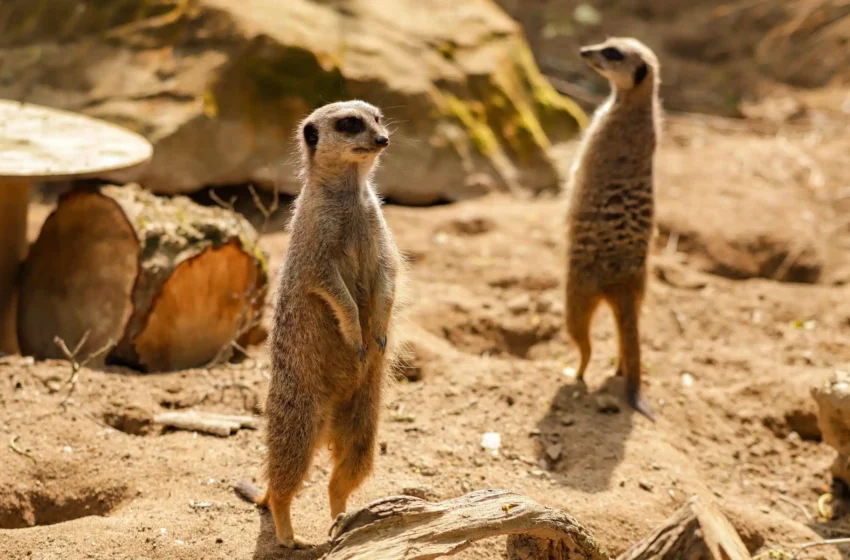10 fascinating things to know about meerkats

10 fascinating things to know about meerkats
With their upright stance, curious eyes, and tight-knit family dynamics, meerkats have captured hearts across the globe.
Native to the arid deserts of southern Africa, these small mammals are far more complex than their adorable appearance suggests. From their underground cities to their sentinel watch systems, meerkats exhibit intelligence, cooperation, and survival instincts that rival those of much larger animals.
Whether you’ve seen them in documentaries, memes, or on safari, there’s always more to learn about these desert sentinels.
In this article, we uncover 10 fascinating facts about meerkats that reveal just how remarkable—and underrated—these animals truly are.
1. Meerkats Are Not Cats—They’re a Type of Mongoose
Despite the name “meerkat,” these creatures are not cats at all. They belong to the mongoose family (Herpestidae). Their scientific name is Suricata suricatta, and they are small carnivorous mammals native to southern Africa. Their sleek bodies, long tails, and pointed snouts make them distinct from both cats and traditional mongooses.
2. They Live in Complex Underground Burrows
One of the meerkat’s most impressive traits is its ability to dig elaborate underground tunnel systems. These burrows can stretch over 15 feet and have multiple entrances and chambers used for sleeping, hiding from predators, and regulating body temperature. The soft, sandy soils of deserts like the Kalahari and Namib provide the perfect landscape for their digging prowess.
3. They Are Highly Social and Live in ‘Mobs’
Meerkats live in tight-knit social groups known as mobs, gangs, or clans—usually consisting of 10 to 40 members. These groups work cooperatively in every aspect of life: raising pups, foraging, standing guard, and defending territory. Their social structure is sophisticated, with an alpha pair (usually the dominant female and her mate) leading the group.
4. They Use a Sentinel System to Watch for Predators
A signature meerkat behavior is their sentry or lookout duty. While others forage or play, one meerkat stands on its hind legs to keep watch. If danger approaches—like a hawk, jackal, or snake—the sentry lets out a sharp bark or whistle to alert the rest of the group to dive for cover. This cooperative strategy significantly boosts their survival odds in harsh environments.
5. Meerkats Communicate with Over 30 Distinct Sounds
Meerkats are extremely vocal animals. Researchers have identified more than 30 different vocalizations, including chirps, growls, trills, barks, and alarm calls. Each sound carries specific meaning—ranging from casual contact calls during foraging to urgent warnings about predators. Their vocal complexity rivals that of dolphins and primates.
6. They Can Eat Poisonous Insects and Reptiles
Thanks to their specialized immunity, meerkats can safely eat scorpions, centipedes, and even venomous snakes. They learn to remove a scorpion’s stinger before consumption, a behavior passed from adults to pups through observation. This unique skill allows them to thrive in environments where food can be scarce and dangerous.
7. Baby Meerkats Are Raised by the Whole Group
Parenting is a shared responsibility in meerkat societies. While the dominant female usually gives birth, aunties, uncles, and siblings help raise the young. Some adults serve as babysitters, while others teach pups how to hunt by offering live prey in staged lessons. This alloparental care boosts survival rates and strengthens the mob’s cohesion.
8. They Are Diurnal and Rest at Night
Meerkats are strictly diurnal, meaning they are active during the day and return to their burrows by sunset. At dawn, they often gather at the entrance to warm themselves under the sun before starting their daily routine. Their body clocks are tightly aligned with daylight, and they avoid activity at night due to predators and temperature drops.
9. They Are Found Only in Southern Africa
Despite their internet fame, meerkats are not found globally. They are native only to southern Africa, particularly in countries like Botswana, Namibia, South Africa, and parts of Angola. They prefer open arid regions like the Kalahari Desert, where they can dig easily and scan for danger across vast terrain.
READ ALSO
Where are meerkats most common in the world? A look at their native habitats
Meerkat meme mania: How a toothpick-holding animal took over Nigerian and South African social media
Pawpaw vs. Meerkat: How two meme legends captured the Nigerian Internet
Meerkat meme fever: Nigerian celebrities who have joined the viral trend
What’s a meerkat? All to know about animal behind Nigeria’s viral meme
How a meerkat became Nigeria’s latest meme star
10. They Have Become Icons of Wildlife Media and Pop Culture
From BBC’s “Meerkat Manor” to viral memes and AI-generated artwork, meerkats have carved a niche in pop culture. Their curious postures, expressive faces, and group behavior make them highly photogenic and relatable. They’re often used in advertising and animated films to depict intelligence, loyalty, or comic alertness.
Meerkats may be small, but their intelligence, social sophistication, and survival instincts make them one of the most fascinating creatures in the animal kingdom. Whether standing guard in the Kalahari or starring in internet memes, meerkats continue to captivate scientists and animal lovers alike.



